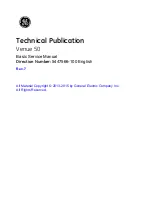
HORIZONTAL CONTROLS
20.
Main Time Base TIME/DIV Control. Provides step
selection of sweep rate for the main time base. When
the VARiable Sweep control is set to CAL, sweep rate
is calibrated. This control has 23 steps, from 20 nS/div
to 0.5 S/div, in a 1-2-5 sequence.
21.
DELAY Time Base TIME/DIV Control. Provides
step selection of sweep rate for delayed sweep time
base. This control has 23 steps, from 20 nS/div to
0.5 S/div, in a 1-2-5 sequence.
22.
DELAY TIME POSition Control. Sets starting point
of delayed sweep. Clockwise rotation causes delayed
sweep to begin earlier.
23.
VARiable Sweep Control. Rotation of control is ver-
nier adjustment for sweep rate. In fully clockwise
(CAL) position, sweep rate is calibrated. This control
is the vernier adjustment for both the main and delayed
time bases.
24.
POSition/PULL X10 MAG Control.
POSition:
Horizontal (X) position control.
PULL X10 MAG:
Selects ten times sweep magnification when pulled
out, normal when pushed in. Increases maximum
sweep rate to 10 nS/div.
25.
Sweep Mode Switch. Selects sweep (horizontal)
mode. Four-position rotary switch with the following
positions:
MAIN:
Only the main sweep operates, with the delayed
sweep inactive.
MIX:
The main and delayed sweep share a single trace;
main sweep occupies the left portion of the display;
delayed sweep occupies the right portion of the
display. The DELAY TIME POSition control de-
termines the percentage of display that is main
sweep and the percentage of display that is delayed
sweep (main sweep is usually brighter than the
delayed sweep). Delayed sweep speed cannot be
slower than main sweep speed.
DELAY:
Only delayed sweep operates, while main sweep
stays inactive. DELAY TIME POSition control
determines the starting point of the delayed sweep.
X-Y:
Used with the VERTical MODE switch and Trig-
ger SOURCE switch to select X-Y operating
mode. The channel 1 input becomes the X-axis and
the channel 2 input becomes the Y-axis. Trigger
source and coupling are disabled in this mode.
TRIGGERING CONTROLS
26.
HOLDOFF/PULL NORM TRIG Control.
HOLDOFF:
Rotation adjusts holdoff time (trigger inhibit period
beyond sweep duration). When control is rotated
fully counterclockwise, the holdoff period is MIN-
inum (normal). The holdoff period increases pro-
gressively with clockwise rotation.
PULL NORM TRIG:
When pushed in, selects automatic triggering mode.
In this mode, the oscilloscope generates sweep (free
runs) in absence of an adequate trigger; it automat-
ically reverts to triggered sweep operation when an
adequate trigger signal is present. Automatic trig-
gering is applicable to both the main sweep and
delayed sweep. When pulled out, selects normal
triggered sweep operation. A sweep is generated
only when an adequate trigger signal is present.
27.
Trigger SOURCE Switch. Selects source of sweep
trigger. Four-position lever switch with the following
positions:
CH1/X-Y
CH1:
Causes the channel 1 input signal to become the
sweep trigger, regardless of the VERTical
MODE switch setting.
X-Y:
Used with two other switches to enable the X-Y
mode — see the Operating Instructions under
“XY Operation”.
CH2:
The channel 2 signal becomes the sweep trigger,
regardless of the VERTical MODE switch setting.
ALT:
Alternate triggering, used in dual-trace mode, per-
mits each waveform viewed to become its own
trigger source.
EXT:
Signal from EXTernal TRIGger jack becomes
sweep trigger.
28.
Trigger COUPLING Switch. Selects trigger cou-
pling. Four-position lever switch with the following
positions:
AC:
Trigger signal is capacitively coupled.
TV-V:
Used for triggering from television vertical sync
pulses. Also serves as lo-pass/dc (high frequency
reject) trigger coupling.
CONTROLS AND INDICATORS
9










































